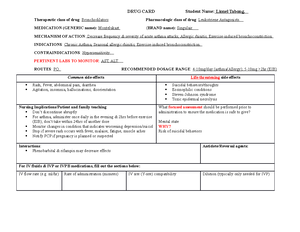- Information
- AI Chat
Was this document helpful?
Insulin Glargine Drug Card
Course: Pharmacology (NURS 3308)
112 Documents
Students shared 112 documents in this course
University: Texas Tech University
Was this document helpful?

DRUG CARD Student Name: Lionel Tabong
Therapeutic class of drug: Hormones Pharmacologic class of drug: Pancreatics
MEDICATION (GENERIC name): Insulin Glargine (BRAND name): Basaglar/Lantus.
MECHANISM OF ACTION: Lowers blood glucose by stimulating glucose uptake in skeletal muscle & fat, inhibit hepatic glucose production
INDICATIONS: Control of hyperglycemia in type 1 & 2 DM Pts.
CONTRAINDICATIONS: Hypoglycemia, Hypersensitivity.
PERTINENT LABS TO MONITOR: blood glucose, Hemoglobin A1C, K.
ROUTES: Subqut RECOMMENDED DOSAGE RANGE: 0.2-0.4 units/kg (starting dose)
Common side-effects Life-threatening side effects
Hypokalemia
Lipohypertrophy, erythema, swelling, pruritis (local)
Hypoglycemia
Anaphylaxis
Nursing Implications/Patient and family teaching:
Don’t mix with any other insulin/solution, it should be clear & colorless
Use only insulin syringes to draw up dose & store unopened vials in
fridge, don’t freeze. Don’t share pen device.
Administer subcut once daily at the same time each day
Assess/monitor symptoms of hypoglycemia (tingling extremities,
cool/pale skin, tremors, tachycardia, excessive hunger, chills, sweats)
What focused assessment should be performed prior to
administration to ensure the medication is safe to give?
Signs of hypoglycemia – tachycardia, chills, tremors, weakness,
tingling extremities, headache, cool/pale skin, confusion
WHY?
Risk of hypoglycemia
Interactions:
Beta blockers, clonidine & reserpine may mask signs of hypoglycemia
Corticosteroids, estrogen, isoniazid, niacin & rifampin may increase insulin requirements
Alcohol, ACE inhibitors, MAOIs, oral hypoglycemics, salicylates may reduce requirement
Glucosamine may worsen blood glucose control
Antidote/Reversal agents:
Oral/IV glucose
Glucagon
Epinephrine
For IV fluids & IVP or IVPB medications, fill out the sections below:
IV flow rate (e.g. ml/hr) Rate of administration (minutes) IV site (Y-site) compatibility Dilution (typically only needed for IVP)






